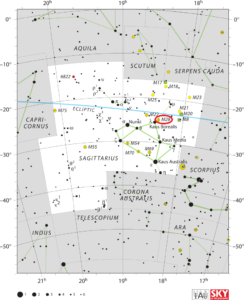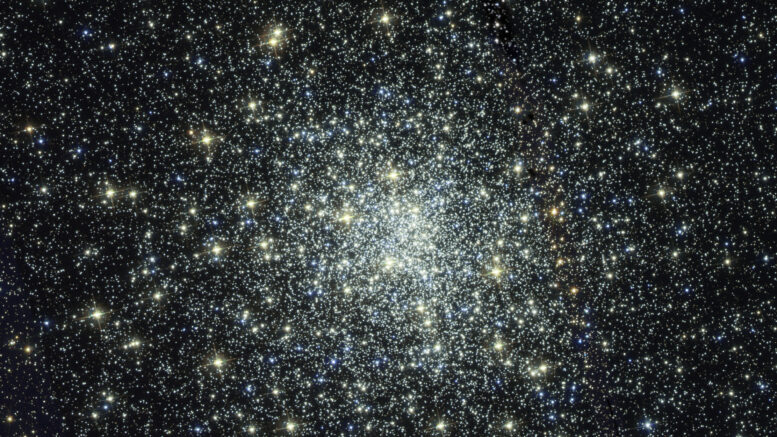Messier 28 was the first globular cluster discovered to contain a milisecond pulsar, a pulsating, highly magnetized rotating neutron star emitting a beam of electromagnetic radiation with a rotational period between 1 and 10 miliseconds.
| Description | |
| Visible From Pacific Northwest | Late April to September |
| Best Time To Observe | July and August |
| Minimum Size Of Viewing Device | Binoculars |
| Object Type | Globular Cluster |
| Designations | Messier 28, M28, NGC 6626, C 1821-249, GCl 94, MWSC 2908, h 2010 |
| Right Ascension | 18h 24m 32.89s |
| Declination | -24°52’11.4” |
| Constellation | 17,900 light years |
| Number Of Stars | >50,000 |
| Apparent magnitude | +7.66 |
| Apparent dimensions | 11′.2 |
| Object Radius | 30 light years |
| Distance From Earth | 17,900 light years |
History
Messier 28 was one of Charles Messier’s original discoveries. The comet hunter first observed the cluster on July 27, 1764 and added it to his catalogue. He wrote:
In the night of the 26th to the 27th of the same month, I have discovered a nebula in the upper part of the bow of Sagittarius, at about 1 degree from the star Lambda of that constellation, & little distant from the beautiful nebula which is between the head & the bow [Messier 22]: that new one may be the third of the older one, & doesn’t contain any star, as far as I have been able to judge when examining it with a good Gregorian telescope which magnifies 104 times: it is round, its diameter is about 2 minutes of arc; one sees it with difficulty with an ordinary refractor of 3 feet & a half of length. I have compared the middle [of it] with the star Lambda Sagittarii, & I have concluded its right ascension of 272d 29′ 30″, & its declination of 37d 11′ 57″ south.
William Herschel was able to resolve the cluster’s stars more than three decades later. On August 1, 1799, he noted, “It may be called insulated though situated in a part of the heavens that is very rich in stars. It may have a nucleus, for it is much compressed towards the centre, and the situation is too low for seeing it well. The stars of the cluster are pretty numerous.”
The pulsar, catalogued as PSR B1821–24, was discovered in 1986 using the Lovell Telescope, a radio telescope at Jodrell Bank Observatory in Cheshire, England. Researchers later discovered 11 more milisecond pulsars in the same area, which makes M28 a cluster with the third largest population of pulsars, after the globular clusters Terzan 5, also located in Sagittarius, and 47 Tucanae in Tucana constellation.
Locating M28 In The Sky
Messier 28 is quite easy to find in the sky as it lies less than a degree northwest of Kaus Borealis, one of the bright stars forming the Teapot asterism in Sagittarius.

Viewing M28
As M28 is not particularly bright, it is invisible to the naked eye and only appears as a faint patch of light in binoculars. Small telescopes will show a nebulous object occupying an area of 11.2 arc minutes in apparent diameter, while medium-sized and larger telescopes will reveal the cluster’s bright core and resolve the stars. Individual stars can only be seen in 4-inch and larger instruments.
Photographing M28
Open clusters are a great thing to photograph as they provide an opportunity to capture a lot of stars at once and they are bright objects. Photographing M28 can be done a plethora of ways, but is not necessarily the most popular object in the sky. There is limited information available on the potential options for someone looking for suggestions and a starting point, however, there are some great options for DSLRs with 300 second exposures at ISO 800 with an F/2.8. Autoguiding will need to be precise as stars could lose their crispness and drift if not perfectly tracking.
Sources And Further Reading
Descriptions of all of Messier Objects can be found here
https://www.nasa.gov/feature/goddard/2017/messier-28

Be the first to comment on "Messier 28"